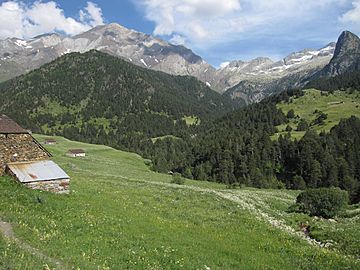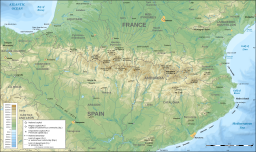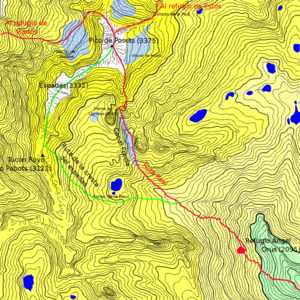Pico Posets facts for kids
Quick facts for kids Pico Posets |
|
|---|---|
| Punta de Llardana | |

Pico Posets from the west
|
|
| Highest point | |
| Elevation | 3,369 m (11,053 ft) |
| Prominence | 1,125 m (3,691 ft) |
| Geography | |
| Location | Eriste, Benasque valley (Ribagorza, Aragon, Spain) |
| Parent range | Pyrenees |
| Climbing | |
| First ascent | August 6, 1856 (H. Halkett) |
| Easiest route | basic snow/ice climb from Angel Orús refuge |
Pico Posets, also known as Punta de Llardana, is a very tall mountain in the Pyrenees mountain range. It is the second highest peak in the Pyrenees, right after Aneto. This amazing mountain is located in the Spanish province of Huesca. It stands at a height of 3,369 metres (11,053 ft), which is over two miles high!
Contents
Climbing to the Top: The Ascent Route
If you want to climb Pico Posets, a common starting point is the Angel Orús refuge. This refuge is like a mountain hut, located at 2,095 meters (about 6,873 feet) above sea level. From there, a clear path leads towards the northwest.
After about an hour of walking uphill, you will cross a small stream. The path then splits into two directions. To reach the summit, you should take the path on the right. This path goes into a narrow valley called Canal Fonda.
What to Bring for the Climb
The Canal Fonda often has snow and ice almost all year round, even in summer! Because of this, it's a good idea to bring special climbing tools. You will need an ice axe (a tool that looks like a pickaxe, used to help you climb on ice and snow) and crampons (metal spikes that attach to your boots to give you grip on ice).
In less than three hours from the refuge, the path will bring you to the base of a rock formation known as the Tooth of Llardana. Many climbers choose to climb this smaller peak on their way back down from the main summit.
After the Tooth of Llardana, you will continue climbing a rocky slope. If you keep going for about four hours from the refuge, you will finally reach the very top of Pico Posets!
The Way Down
The journey back down to the Angel Orús refuge usually follows the same path you took to go up. The descent typically takes about three hours. It's important to be careful on the way down, especially in the snowy sections.
More to Explore
See also
 In Spanish: Pico Posets para niños
In Spanish: Pico Posets para niños




